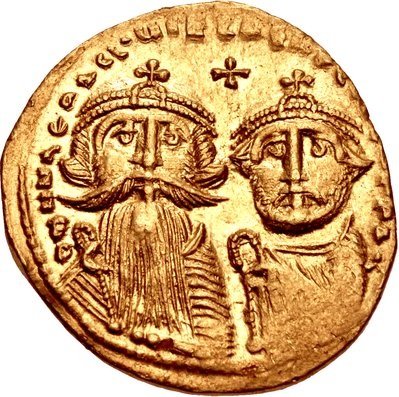On January 22, 613, a significant event took place in Constantinople, marking the coronation of eight-month-old Constantine as co-emperor by his father, Emperor Heraclius. This early medieval ceremony not only symbolized the continuation of the Byzantine practice of dynastic succession but also played a crucial role in ensuring the stability of Heraclius’ reign and the future succession of the Byzantine Empire, especially during a period of significant political and military challenges.
The coronation of Constantine as co-emperor was a strategic move by Emperor Heraclius to secure the future of the Byzantine Empire. By designating his young son as co-emperor, Heraclius aimed to establish a clear line of succession and prevent any potential power struggles or disputes over the imperial throne. This practice of co-emperorship had been a long-standing tradition in the Byzantine Empire, allowing for a smooth transition of power from one generation to the next.
Heraclius’ decision to crown Constantine at such a tender age may seem unusual to modern-day observers. However, it was not uncommon in the Byzantine Empire for infants or young children to be crowned as co-emperors. The rationale behind this practice was to ensure the longevity of the dynasty and to provide a stable and secure future for the empire.
The coronation ceremony itself would have been a grand affair, befitting the Byzantine imperial tradition. The young Constantine would have been dressed in regal attire, adorned with jewels and symbols of power. The ceremony would have been attended by members of the imperial court, high-ranking officials, and religious figures, all bearing witness to the official proclamation of Constantine as co-emperor.
This event holds particular historical significance due to the political and military challenges faced by the Byzantine Empire during this period. The early 7th century was a turbulent time for the empire, with external threats and internal conflicts posing significant risks to its stability. The Byzantine Empire was engaged in a protracted war with the Sassanian Persian Empire, which had ravaged the eastern provinces and brought the empire to the brink of collapse.
In addition to the Persian threat, the Byzantine Empire was also facing incursions from the Avars, Slavs, and other barbarian tribes. These invasions posed a direct threat to the empire’s territorial integrity and further strained its military resources. Against this backdrop of external aggression and internal turmoil, the coronation of Constantine as co-emperor served as a symbol of continuity and strength for the Byzantine Empire.
The decision to crown Constantine at such a young age also had practical implications. It allowed Heraclius to groom his son for future leadership, ensuring a smooth transition of power when the time came. By involving Constantine in the affairs of the empire from an early age, Heraclius could impart his wisdom and experience, preparing his son to take on the responsibilities of ruling the Byzantine Empire.
The coronation of Constantine as co-emperor in 613 marked a pivotal moment in Byzantine history. It demonstrated the commitment of Emperor Heraclius to the preservation of the empire and the continuation of the Byzantine imperial tradition. The event ensured the stability of Heraclius’ reign and laid the foundation for the future succession of the Byzantine Empire.
To delve deeper into the historical context and significance of the coronation of Constantine as co-emperor, interested readers can refer to reputable external references such as:
1. “Byzantium: The Early Centuries” by John Julius Norwich – This comprehensive book provides a detailed account of the Byzantine Empire during the early medieval period, including the coronation of Constantine as co-emperor.
2. “The Byzantine Empire” by Charles Oman – A classic work on Byzantine history, this book offers insights into the political and military challenges faced by the empire and the importance of dynastic succession.
3. “Heraclius: Emperor of Byzantium” by Walter E. Kaegi – This scholarly work focuses specifically on the reign of Heraclius and sheds light on his decision to crown Constantine as co-emperor.
In conclusion, the coronation of Constantine as co-emperor in 613 played a crucial role in ensuring the stability and future succession of the Byzantine Empire during a period of significant challenges. This event symbolized the continuation of the Byzantine practice of dynastic succession and demonstrated Emperor Heraclius’ commitment to the preservation of the empire. The coronation of Constantine as co-emperor remains a significant milestone in Byzantine history, highlighting the importance of strategic planning and foresight in securing the future of an empire.

